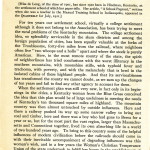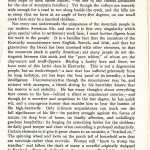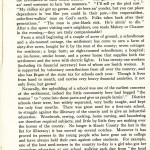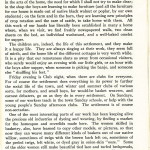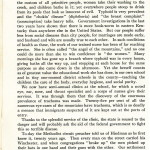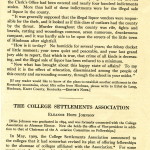Pine Mountain Settlement School
Series 09: Biography
Series 27: Scrapbooks
ETHEL de LONG Writing “Doings on Troublesome”
TAGS: Ethel de Long , writing, Troublesome Creek, Knott County, KY, Smith College, Hindman Settlement School, diphtheria, typhoid.
Ethel de Long – “Doings on Troublesome,” [Hindman Settlement School, Knott County, KY]
Located in the SCRAPBOOK BEFORE 1929 in the Pine Mountain Settlement School Collections, this article was written in 1912 by Ethel de Long while she was still employed by Hindman Settlement School and before the founding of Pine Mountain Settlement School. The article was written for the Smith Alumnae Quarterly and captures the environment of the region just prior to the creation of the Harlan County settlement school.
GALLERY: ETHEL de LONG Doings on Troublesome
De Long, Ethel. “Doings on Troublesome,” Smith Alumnae Quarterly, July 11, 1912. Pine Mountain Settlement School Collections. Print
TRANSCRIPTION: ETHEL de LONG Doings on Troublesome
[Miss de Long, of the class of 1901, has since 1910 been in Hindman, Kentucky, at the settlement school of which her paper tells. Her article, “A School Pageant,” written when she was a teacher in the Manual Training School in Indianapolis, appeared in the [Smith] quarterly for July 11, 1912.]
DOINGS ON TROUBLESOME
Ethel de Long
For ten years our settlement school, virtually a college settlement although it does not belong to the Association, has been trying to meet the rural problems of the Kentucky mountains. The college settlement idea, so splendidly serviceable in the slum districts and among the foreign population of cities, has been equally valuable at the forks of the Troublesome, forty-five miles from the railroad, where neighbors often live “two whoops and a hollo” apart and where the stock is purely American. Here, in the most remote county of the state, the spirit of neighborliness has tried conclusions with the worst illiteracy in the southern mountains, with moonshine stills, with typhoid fever and trachoma, with poverty, and with the melancholy that is bred in the isolated cabins of these highland people. And that its serviceableness has transformed the county we cannot doubt, as we sum up the changes of ten years and fail to find any other agency to account for them.
When the settlement plan was still very new, in fact only in its beginnings in the cities, a Kentucky woman from the Blue Grass conceived the idea that this plan would be of large usefulness in meeting the needs of Kentucky’s ten thousand square miles of highland. The mountain country was then almost untouched by outside influences. Here and there a railway pushed its way up some narrow valley to bring out coal and timber, here and there was a boy who had gone to Berea for a year or so, but for the most part the vast region, larger than Massachusetts and Connecticut together, lived its own absorbing life in a world of two’ hundred years ago. To bring to this country some of the helpful influences of modern civilization before the railroads should come in with their inevitable accompaniment of degrading influences was this woman’s wish, and in a few years the Woman’s Christian Temperance Union of the state undertook to fulfill her hopes in the establishment of this settlement in Knott County.
It was a settlement with a great opportunity. Those who are acquainted only with the sparsely settled Northern Appalachians have no conception of how large a population the Southern Appalachians nourish, on the steep hillsides and in the narrow valleys. Yet the mountain counties of eastern Kentucky with a population of more than 300,000 are much more thickly peopled than is the Blue Grass region of the state. Indeed, to one viewing the country from any of its mountain
tops, its aspect is so remote and un-peopled that it is hard to believe in the little gray cabins, only a “sight” or two apart all up and down the creeks, and each one overflowing with children. [For ” ‘pears like a body ought to have twelve chill en,”—so one of our friends accounted for the size of mountain families.] Yet though the valleys are scarcely wide enough for a road to run along beside the creek, and the hills are so steep that we farm at an angle of forty-five degrees, on one small creek there may be a hundred children.
Not every one understands the uniqueness of the mountain people in our modern American life, and since it is this very singularity which gives special value to settlement work here, I must further digress from the work to the people. It is a familiar fact that the ancestors of the Kentucky mountaineers were English, Scotch, and Irish, and that for generations the blood has been unmixed with other elements, so that the mountain stock is purely American; yet many people do not distinguish between this stock and the “poor whites,” of whom are the clay-eaters and snuff-dippers. Barring a family here and there, we have none of this latter class in Kentucky. This is not a degenerate people, but an undeveloped,—a race that has suffered grievously from its long isolation, yet has kept the best proof of its heredity, a keen intelligence. Uncommunicative though the mountaineer may be, and reticent with strangers, a friend sitting by his hearth fire knows that his reserve is not stolidity. He has many thoughts about everything that comes to his ken — behind a silent or acquiescent exterior, — and though he is secretive and suspicious to the last degree, he has quick wit, and a courageous humor that enables him to bear the burden of life high-heartedly. Only intimate acquaintance can teach one the full significance of his life:—its patient struggle against the forces of nature; its deep love of home, its family affection, and unfailingly gracious hospitality; its longing for something better for the children; its daily good temper and cheer often concealing a profound melancholy. Certain elements in it give it great charm to an outsider, a “fetched on.” The spinning wheel and loom on the porch tell of household arts that are survivals rather than revivals. Women still “know to tromp the treadles,” and follow the draft of many a coverlid originally designed in England. From the hills where the men are pullin’ fodder or jinnm’ cane come the unforgettably mournful strains of an old English ballad or a funeral meetin’ hymn from Thomas’s hymnal. Perhaps, when the beautiful peace of evening in the hills has descended and the family are gathered round the fire, someone may pick the dulcimer and sing “Sourwood Mountain,” or the children may dance an elsewhere forgotten country dance.
The speech of the country people,—I wish for an unfailing memory to retain its precious quaintness. “My baby is motley-faced. Hit’s been play in’ in the dirt all day.” “I thirst after readin’, but my boys don’t take no delight in their books.” “He’s been a down-headed man since allus ago, but she’s upheaded an’ sprightly, an’ they don’t have the favorances of each other, nohow.” “The gals air rude an’ gayly an’ need someone to larn ’em manners.” “I’ll sell ye the pied cow.” “My chillen air got up grown, an’ air here an’ yonder, but you can place dependence in ’em like you could in their paw,—the respectablest, orderliest-walkin’ man on God’s earth. Folks takes back after their generations.” “The man is pint-blank sick. He’s aimin’ to die.” After a day spent visiting one’s neighbors, one reads Malory or Chaucer in the evening,—they are truly companionable!
From a small beginning of a couple of acres of ground, a schoolhouse and a six-roomed cottage, the settlement has come to own a farm of sixty-five acres, bought for it by the men of the county; seven cottages for residence; a large barn; an eight-roomed schoolhouse; a hospital; an ice-house, smoke house, and a power house that supplies both the settlement and the town with electric lights. It has twenty-one workers (including its financial secretary) four of whom are Smith women. It is supported by voluntary contributions from all over the country, and also has $1400 of the state tax for schools each year. Though it lives from hand to mouth, and carries very heavy financial anxieties, it not only lives, but grows!
Naturally, the upbuilding of a school was one of the earliest concerns of the settlement, indeed the little community here had begged “the women” to “come into these parts and give us people larnin’.” District schools there were, but widely separated, very badly taught, and kept for only four months. There was great need for a first-rate school, to struggle against the illiteracy of the county and to give an industrial education. Woodwork, sewing, cooking, home nursing, and laundering are therefore required subjects, and little by little they are making over the homes of the county. No longer is Knott County the last in the list for illiteracy; it has moved up several notches. Moreover it has proved its powers in the young people who have gone out to college and have always held their own against other students. For example, one of the best seed-testers in the country to-day is a girl who got her secondary education at our school, walking each day from “the head of a holler” four miles away, no matter what the weather.
It is possible for us to-day to take into our own homes children from far out in the country, and we have in our colleges a hundred boys and girls who came to us from twelve, twenty — even sixty-five miles away. So slightly can we touch the needs of our neighborhood that we have turned away over a thousand children, and we hear everywhere we go “This whole country is a lookin’ to you women to educate the children.’ Each child in our household earns his scholarship by four and a half hours of work every day, — indeed we have but three hired helpers in our family, and if we had a mint of money we should continue to do our own work. For in the laundry and the kitchen children get training in the arts of the home, the need for which I shall not try to make clear; in the shop the boys are learning to make furniture (and all the furniture for our house is made out of native black walnut or poplar, by our own students); on the farm and in the barn, they are learning new principles of crop rotation and the care of cattle, to take home with them. All this work of our hands has literally been established in many a home where, when we visit, we find freshly newspapered walls, two clean sheets on the bed, an individual washstand, and a well-baked omelet for supper.
The children are, indeed, the life of this settlement, and they make it a happy life. They are always singing at their work, they seem full of mirth, and the home life of the different cottages is very worth while. It is a pity that our remoteness shuts us away from occasional visitors, who surely would enjoy an evening with our little girls, or an hour with the boys after supper, when someone is picking the banjo, and someone else “shuffling his feet.”
Friday evening is Club night, when there are clubs for everyone. For of course the settlement does everything in its power to further the social life of the town, and winter and summer clubs of various sorts, for mothers, and small boys, for would-be basket weavers, and earnest debaters, go on as they do in every settlement. On Sundays, some of our workers teach in the town Sunday schools, or help with the young people’s Sunday afternoon clubs. The settlement is of course non-sectarian.
One of the most interesting parts of our work has been keeping alive the precious old industries of dyeing and weaving, by finding a market for the homespun and coverlids made here. The women skilled in basketry, also, have learned to copy other models, or pictures, so that now they can weave many different kinds of baskets out of our native willow, sometimes of twigs with the brown bark left on, sometimes of the peeled twigs, left white, or dyed gray in onion-skin “ooze.” Some of the older women still make beautiful tied lace and turfed bedspreads, and we are trying to have the young ones learn these arts. Yet here, as everywhere, it is hard to keep interest in hand products alive, with machine-made goods coming in cheap. In the ten years, we have sold over $9000 worth of homespun and baskets for the people. The ready money so earned is often the only money for the household, and gets spent for such “store” goods as false teeth and cook-stoves!
Naturally in a region where there is so much ignorance and such a lack of proper living conditions, hospital work is tremendously important. The difficulties of practical sanitation in the mountains are enormous.
Inevitably in a country of such narrow valleys all drainage reaches the creeks. The waters look clear, and to a people ignorant of the germ theory what more natural than to use it for washing the vegetables and the chickens when the spring or well is not conveniently near? After the custom of all primitive people, women take their washing to the creek, and children bathe in it; yet everywhere people stoop to drink from its pools that look so innocent of evil. Typhoid is very prevalent and the “chokin’ disease” (diphtheria) and “the breast complaint” (consumption) take heavy tolls. Government investigations in the last two years have shown that there is more hook-worm in eastern Kentucky than anywhere else in the United States. But our people suffer less from social diseases than city people, for marriages are made early, and husband and wife are usually true to each other. In such conditions of health as these, the work of our trained nurse has been of far-reaching service. She is often called “the angel of the mountains,” and no one could do more than she to win confidence in “the women.” Many mornings she has gone up a branch where typhoid was in every house, giving baths all the way up, and stopping at each house for the same purpose as she came down in the afternoon. Yet she herself counts as of greatest value the educational work she has done, in our own school and in tiny one-roomed district schools in the county —teaching the children the care of the body, everyday hygiene, and social purity.
We now have semi-annual clinics at the school, for which a noted eye, ear, nose, and throat specialist and a corps of nurses give their services. It was through them that the discovery of the enormous prevalence of trachoma was made. Twenty-five per cent of all the numerous eye-cases of the mountains have trachoma, which is so deadly a menace that immigrants suspected of it are kept out at the ports of entry. Thanks to the splendid service of the clinic, the state is roused to the danger and will probably ask the aid of the federal government to fight this so terrible disease.
Today the Methodist circuit preacher told us of Hindman as he first knew it, twenty years ago. Then every man on the street carried his Winchester, and when congregations “broke up” the men picked up their hats in one hand and their guns with the other. Our settlement has made no active campaign against the violence and passion of those days — it has simply done its neighborly duty, in a quiet way. Education, the cultivation of new resources, widening contact, have changed our county almost beyond recognition, as any of the older folks will tell you. The vast region of the mountains is scarcely touched as yet, but we know what the settlement spirit can do for it. Lest this be taken cautiously, as a too enthusiastic opinion, I quote from the address of the Circuit Judge, before the Knott County Grand Jury, in June 1912.
“The people of Knott County, more than any other of eastern Kentucky, are to be congratulated upon the decrease of crime within the County. Eight years ago when I first came to this county to hold your Circuit Court, I found that on the Saturday night before my arrival, the Clerk’s Office had been entered and nearly four hundred indictments stolen. More than half of these indictments were for the illegal sale of liquor in the county.
“It was generally supposed that the illegal liquor vendors were responsible for the theft, and it looked as if this class of outlaws had the county by the throat. Murder throughout the county was rife, fights and brawls, cutting and woundings common, arson numerous, drunkenness rampant, and it was hardly safe to be upon the streets of the little town of Hindman after nightfall.”
“How is it today? No homicide for several years; the felony docket of little moment; your town quiet and peaceable, and your last grand jury able to report, that which is true, that crime of all kinds is decreasing, and the illegal sale of liquor has been reduced to a minimum.
“Now what has brought about this happy state of affairs? To my mind it is the effect of education, disseminated among the people of this county and surrounding country, through the school in your midst.”
[If any reader would like to know of the plans to establish another settlement in the Kentucky mountains, about fifty miles from Hindman, please write to Ethel de Long. [ Hindman, Knott County, Kentucky.—editor’s note.] “Doings on Troublesome” by Ethel de Long (1911)A brief article written by Ethel De Long while she was working at Hindman Settlement School in Perry County, Kentucky in 1910. The article appeared in the Smith Alumnae Quarterly in July of 1912. Ethel de Long departed Hindman School in 1912 with Katherine Pettit to found the Pine Mountain Settlement School, established in 1913. She married Luigi Zande and became Ethel de Long Zande.|
|
|
| Title | “Doings on Troublesome” |
| Alt. Title | |
| Creator | Ethel de Long |
| Identifier | Permalink: https://pinemountainsettlement.net/?page_id=4936 |
| Subject Keyword | Ethel de Long ; Hindman Settlement School ; Pine Mountain Settlement School ; Troublesome Creek ; schools ; education ; settlement schools ; Smith College ; W.C.T.U. ; settlement school movement ; Knott County ; literacy ; writing |
| Subject LCSH | Hindman Settlement School — Knott County — Kentucky Pine Mountain Settlement School — Harlan County — Kentucky |
| Description | A brief article written for the Smith Alumnae Quarterly in July, 1911, by Ethel de Long, a graduate of the college in 1901. The article describes the work in which she was engaged and the life of the people living on Troublesome Creek in Knott County, Kentucky. |
| Publisher | Smith Alumnae Quarterly, Smith College |
| Contributor | |
| Date | Date of article – July 11, 1911 ; Date digital – 2008 ; 2013 |
| Type | Collection ; Text |
| Format | 1 short article. |
| Source | Pine Mountain Settlement School archive ; scrapbook 1 |
| Language | English |
| Relation | Series 27: Scrapbook to 1929. A Pine Mountain Settlement School scrapbook. |
| Coverage temporal | 1910-1912 |
| Coverage spatial | Hindman Settlement School, Knott County, KY |
| Rights | Any display, publication, or public use must credit the Pine Mountain Settlement School, Pine Mountain, KY. Copyright retained by the creators of certain items in the collection, or their descendants, as stipulated by United States copyright law. |
| Donor | n/a |
| Acquisition | |
| Citation | De Long, Ethel. “Doings on Troublesome,” Smith Alumnae Quarterly, July 11, 1912. Pine Mountain Settlement School Collections. Print |
| Processed by | Helen Hayes Wykle |
| Last updated | 2008-06-27 hw ; 2013-12-18 hw |
SEE
ETHEL DE LONG ZANDE Director
ETHEL DE LONG ZANDE Writing Guide

